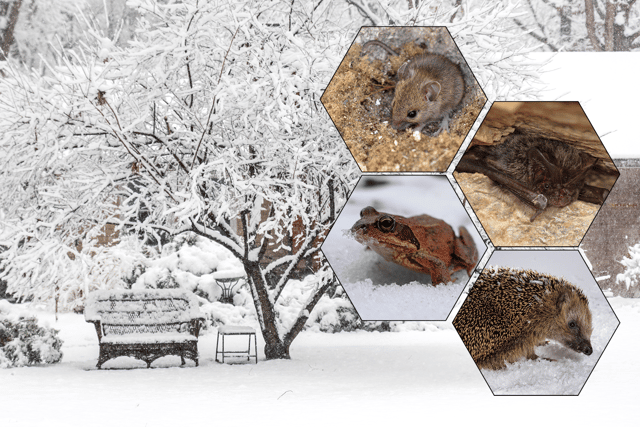Woodland Trust: How to help garden wildlife in the depths of winter - and protect hibernating creatures
and live on Freeview channel 276
The coldest days of winter can bring with them big problems for Britain's garden wildlife, but luckily there is plenty you can do to help nature in your own backyard.
The UK is now truly within winter's icy grasp, with heavy snow and sub-zero temperatures closing schools across the country for days this week - while the Met Office is issuing yellow and amber weather warnings for the coming days. This could be bad news for wildlife battling through the cold season, as late autumn food sources run thin, water sources freeze over, and they need to find safe shelter from the chill. Others still are in the midst of hibernation - sometimes in our gardens - and need us to take a little extra care to make it through unscathed.
Advertisement
Hide AdAdvertisement
Hide AdNationalWorld has asked the Woodland Trust what Britons who want to give animals a helping hand in the cold days ahead should do - and how we can best look out for the sleeping critters we share our backyards with. Here's their advice:
What type of wildlife might visit your garden during winter?
Our gardens provide some exceptionally important resources for wildlife active during the winter months - and many will notice them becoming a haven for visiting birds. Feeders with energy-rich treats are incredibly important for many of these garden bird species, who often rely on them to survive cold snaps as berries run out.
But many other animals may visit you garden during winter too, from foxes at dawn and dusk, to the odd badger - which sometimes enter urban areas looking for food. Rabbits and grey squirrels, although not native, are also frequent visitors, while a whole plethora of different species may choose a garden to safely hibernate throughout the winter months.


A Woodland Trust spokesperson told NationalWorld there are a number of things you can do to help the likes of foxes and badgers too. "[The] main thing is to provide a bowl of water that’s regularly changed if it freezes over," they said. "Cat or dog food, or even just apples are suitable if you really want to feed them."
Advertisement
Hide AdAdvertisement
Hide AdOther ways to help wildlife in winter include planting a hedge - preferably native, shrubby border plants - which will provide shelter from the cold and resting places for years to come. If they flower or grow berries for wildlife to eat later in the year, even better. The Trust says species like dogwood, wild honeysuckle, common ivy, field maple, and guelder rose are ideal for this.
It's also a great time to put up bird nesting boxes for the coming spring. If you're gardening, leaving seedheads standing can provide both food for birds and shelter for tiny creatures like ladybirds.
What should I do if I find an animal hibernating?
The Woodland Trust said insects, hedgehogs, amphibians and reptiles will all be dormant in the wintertime, and may be hibernating - or brumating - in the nooks and crannies of your garden.
"Try not to disturb log piles, compost heaps or do lots of cutting down of stems etc in the garden until the spring when disturbance would be less detrimental," a spokesperson said. "If you find a creature, put it back as close to possible to where and how it was and leave it alone."
Advertisement
Hide AdAdvertisement
Hide AdThe Trust says only three groups of native mammals truly hibernate: hedgehogs, dormice, and bats. Tiny dormice often choose a spot on the ground - nestled in leaf piles or at the base of a tree. Hedgehogs prefer building cosy nests under sheds, in disused fire pits, or even in dense, shrubby hedges - like privet or hawthorn. Bats, meanwhile, naturally prefer higher up hiding spots - taking shelter in hollow trees or roof spaces.
However, many other small mammals like rabbits, shrews, and mice also struggle to keep warm over the colder months, and will enter a similar state called 'torpor' - where they rest for shorter periods. They might also choose a cosy spot in a garden shed, log pile, compost heap, or hedge to hunker down in for a while.
Many amphibians and reptiles also 'brumate' - or enter a torpor-like state. The Trust says frogs, toads, and newts may creep under rocks or logs, or lay buried at the bottom of ponds when the temperature really plummets, usually emerging towards the end of January.
Finally, many beloved garden insects also hibernate. Queen bumble bees may bury themselves underground in loose soil, banks of earth and even occasionally flowerpots, before emerging in the spring to rebuild their colony. Besides carefully putting them back if you find them, the Trust says you can help out by planting nectar-rich blossoming plants nearby - so they can replenish their energy when they wake up.
Advertisement
Hide AdAdvertisement
Hide AdBrimstone, peacock and comma butterflies may also settle down in outdoor structures like sheds over the colder months. It's recommended you don't disturb them if at all possible - and they will eventually depart on their own.
Comment Guidelines
National World encourages reader discussion on our stories. User feedback, insights and back-and-forth exchanges add a rich layer of context to reporting. Please review our Community Guidelines before commenting.
